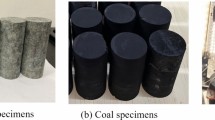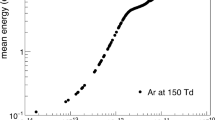Abstract
Detonation properties of mixtures of condensed high explosives with metal additives are studied. A scheme of measurement of high electrical conductivity of detonation products (σ > 10 Ω−1 · cm−1) with a time resolution of ∼ 10 nsec is developed. It is shown that the properties of detonation products depend significantly on the content of the additive in the HE and on dispersion and density of the mixture. The electrical conductivity of detonation products of the compositions examined reaches ∼ 5 · 103 Ω−1 · cm−1, which is more than three orders higher than the electrical conductivity of the HE without the additive. Significant variation of electrical conductivity of detonation products over the conducting region thickness has been found. The main conductivity corresponds to a sector ∼ 1 mm long near the detonation front. The overdriven state of the detonation wave has a strong effect on electrical conductivity and conducting region thickness. It is assumed that the behavior of electrical conductivity with time is caused by successive processes of shock compression of the HE, excitation of the chemical reaction (including the reaction of the additive with detonation products), and expansion of detonation products. The measurement technique used is highly informative due to the possibility of studying detonation in various regimes.
Similar content being viewed by others
REFERENCES
A. A. Brish, M. S. Tarasov, and V. A. Zukerman, “Electrical conductivity of explosion products of condensed high explosives” Zh. Éksp. Teor. Fiz., 37, No. 6 (12), 1543–1549 (1959).
M. A. Cook, The Science of High Explosives, Reinhold, New York (1959).
F. E. Allison, “Detonation studies in electric and magnetic fields” in: Proc. of the 3rd ONR Symp. on Detonation, Office of Naval Research, ACR-52, Vol. 1, Princeton (1960), pp. 112–119.
R. L. Jameson, S. J. Lukasik, and B. J. Pernick, “Electrical resistivity measurements in detonating composition B and pentolite” J. Appl. Phys., 35, Part 1, No. 3, 714–720 (1964).
B. Hayes, “Electrical measurements in reaction zones of high explosives” in: Proc. of the 10th Symp. (Int.) on Combustion (Cambridge, England, 1964), Combustion Inst., Pittsburgh, Pa (1965), pp. 869–874.
B. Hayes, “On the electrical conductivity in detonation products” in: Proc. of the 4th Symp. (Int.) on Detonation (White Oak, MD, 1965), Office of Naval Research, ACR-126, Washington (1967), pp. 595–601.
C. N. McKinnon, “Detonation product electrical conductance enhancement by metallic seeding” in: Proc. of the 10th Symp. on Engineering Aspects of Magneto-Hydrodynamics, M.I.T., Cambridge, Mass. (1969), pp. 91–94.
A. D. Zinchenko, V. N. Smirnov, and A. A. Chvileva, “Measurement of the electrical conductivity of the explosion products of cast 40/60 TNT/RDX” Combust. Expl. Shock Waves, 7, No. 3, 364–367 (1971).
A. N. Dremin, S. A. Koldunov, and K. K. Shvedov, “Changes in the electrical conductivity of shock-initiated explosives” Combust. Expl. Shock Waves, 8, No. 1, 123–125 (1972).
A. N. Dremin and A. N. Mikhailov, “Study of the process of initiation of detonation explosives by shock waves using the method of electrical conductivity” Combust. Expl. Shock Waves, 9, No. 3, 367–370 (1973).
A.! P. Ershov, P. I. Zubkov, and L. A. Luk'yanchikov, “Measurements of the electrical conductivity profile in the detonation front of solid explosives” Combust. Expl. Shock Waves, 10, No. 6, 776–782 (1974).
V. V. Yakushev and A. N. Dremin, “Nature of electrical conductivity of detonation products of condensed explosives” Dokl. Akad. Nauk SSSR, 221, No. 5, 1143–1144 (1975).
A. G. Antipenko, A. N. Dremin, and V. V. Yakushev, “Zone of electrical conductivity in detonation of condensed explosives” Dokl. Akad. Nauk SSSR, 225, No. 5, 1086–1088 (1975).
A. P. Ershov, “Ionization during detonation of solid explosives” Combust. Expl. Shock Waves, 11, No. 6, 798–803 (1975).
K. Tanaka, “Measurement of electrical conductivity in detonation products” Report on 5th Int. Colloquium on Gasdynamics of Explosions and Reactive Systems, Bourges, France (1975).
A. G. Antipenko and V. V. Yakushev, “Nature of electrical conductivity of detonation products of condensed explosives” in: Detonation, Proc. 5th All-Union Symp. on Combustion and Explosion (Odessa, 1977), Joint Inst. Chem. Phys., Acad. Sci. of the USSR, Chernogolovka (1977), pp. 93–96.
A. P. Ershov, P. I. Zubkov, and L. A. Luk'yanchikov, “Nature of electrical conductivity behind the detonation front of condensed explosives” ibid., pp. 89–92.
A. G. Antipenko, A. N. Dremin, and V. V. Yakushev, “Electrical conductivity of tetranitromethane detonation products” Combust. Expl. Shock Waves, 16, No. 4, 458–461 (1980).
A. M. Staver, A. P. Ershov, and A. I. Lyamkin, “Study of detonations in condensed explosives by conduction methods” Combust. Expl. Shock Waves, 20, No. 3, 320–323 (1984).
A. P. Ershov, P. I. Zubkov, Yu. N. Il'yanovich, et al., “Interruption of current with arc shunting by conducting detonation products” in: V. M. Titov and G. I. Shvetsov (eds.), Superstrong Magnetic Fields: Physics, Technology, Application, Proc. 3rd Int. Conf. on Generation of Megagauss Magnetic Fields and Related Experiments (Novosibirsk, 1983), Nauka, Moscow (1984), pp. 397–401.
A. I. El'kind and F. N. Gusar, “SHF measurement of electrical conductivity behind a detonation wave front in TNT” Combust. Expl. Shock Waves, 22, No. 5, 632–636 (1986).
A. A. Reshetov, “Character of the electrical conductivity of detonation products of explosive mixtures” Combust. Expl. Shock Waves, 32, No. 6, 693–695 (1996).
A. P. Ershov, N. P. Satonkina, O. A. Dibirov, et al., “A study of the interaction between the components of heterogeneous explosives by the electrical-conductivity method” Combust. Expl. Shock Waves, 36, No. 5, 639–649 (2000).
S. D. Gilev and A. M. Ryabchun, “Current waves generated by detonation of an explosive in a magnetic field” Combust. Expl. Shock Waves, 37, No. 6, 698–706 (2001).
E. F. Lebedev, V. E. Ostashev, and G. A. Shvetsov, “Conversion of chemical energy in an explosive by a magnetohydrodynamic method” Combust. Expl. Shock Waves, 18, No. 5, 499–512 (1982).
A. P. Ershov, P. I. Zubkov, and L. A. Luk'yanchikov, “Electrophysical properties of a detonation plasma; high-speed explosive circuit breakers” J. Appl. Mech. Tech. Phys., 18, No. 6, 750–753 (1977).
E. I. Bichenkov, S. D. Gilev, and A. M. Trubachev, “Shock-induced conduction waves in electrophysical experiments” J. Appl. Mech. Tech. Phys., 30, No. 2, 291–302 (1989).
S. D. Gilev and A. M. Trubachev, “Shock-induced conduction waves in solids and their applications in high power systems” in: S. C. Schmidt and W. C. Tao (eds.), Shock Compression of Condensed Matter — 1995, Proc. of the Conf. of the Amer. Phys. Soc. Topical Group on Shock Compr. of Cond. Matter Held at Seattle (Washington, August 13–18, 1995), AIP Conference Proceedings 370, Part 2, AIP Press, Woodbury, New York (1996), pp. 933–936.
A. N. Dremin, P. F. Pokhil, and M. I. Arifov, “Effect of aluminum of TNT detonation parameters” Dokl. Akad. Nauk SSSR, 131, No. 5, 1140–1142 (1960).
A. N. Afanasenkov, V. M. Bogomolov, and I. M. Voskoboinikov, “Calculation of detonation-wave parameters in mixtures of high explosives and inert additives” Fiz. Goreniya Vzryva, 6, No. 2, 182–186 (1970).
A. I. Aniskin, “Detonation of aluminum-containing explosives” in: Detonation and Shock Waves [in Russian], Chernogolovka (1986), pp. 26–32.
V. Yu. Davydov, A. M. Grishkin, and I. I. Feodoritov, “Experimental-theoretical investigation of the oxidation of aluminum in detonation waves” Combust. Expl. Shock Waves, 28, No. 5, 564–567 (1992).
A. M. Grishkin, L. V. Dubnov, V. Yu. Davydov, et al., “Effect of powdered aluminum additives on the detonation parameters of high explosives” Combust. Expl. Shock Waves, 29, No. 2, 239–241 (1993).
M. F. Gogulya, A. Yu. Dolgoborodov, and M. A. Brazhnikov, “Fine structure of detonation waves in HMX/Al mixtures” Khim. Fiz., 18, No. 1, 41–44 (1998).
S. D. Gilev and A. M. Trubachev, “Measurement of high electrical conductivity in silicon in shock waves” J. Appl. Mech. Tech. Phys., 29, No. 6, 818–823 (1988).
S. D. Gilev and T. Yu. Mikhailova, “Current wave in shock compression of a substance in a magnetic field” Zh. Tekh. Fiz., 66, No. 5, 1–9 (1996).
S. D. Gilev and T. Yu. Mikhailova, “Electromagnetic processes in a system of conductors formed by a shock wave” Zh. Tekh. Fiz., 66, No. 10, 109–117 (1996).
S. D. Gilev, “Electromagnetic methods for investigation of chemical and phase transformations of solids in a shock wave” in: L. E. Murr, K. P. Staudhammer, and M. A. Meyers (eds.), Metallurgical and Material Applications of Shock-Wave and High-Strain-Rate Phenomena, Proc. of the 1995 Int. Conf. (El Paso, Texas, U.S.A., August 6–10, 1995), Elsevier, Amsterdam (1995), pp. 785–792.
S. D. Gilev and T. Yu. Mihailova, “The development of a method of measuring a condensed matter electroconductivity for investigation of dielectric-metal transitions in a shock wave” J. Phys. IV, 5, C3-211-216 (1997).
K. P. Stanyukovich (ed.), Physics of Explosion [in Russian], Nauka, Moscow (1975).
S. D. Gilev, “Application of the electromagnetic model for diagnosing shock-wave processes in metals” Combust. Expl. Shock Waves, 37, No. 2, 230–235 (2001).
S. D. Gilev, “Electromagnetic effects in a measurement cell for investigating the electrical properties of shock-compressed substances” Combust. Expl. Shock Waves, 30, No. 2, 204–208 (1994).
A. A. Bakanova, I. P. Dudoladov, and Yu. N. Sutulov, “Shock compressibility of porous tungsten, molybdenum, copper, and aluminum in the low pressure domain” J. Appl. Mech. Tech. Phys., 15, No. 2, 241–245 (1974).
A. N. Dremin, K. K. Shvedov, and O. S. Avdonin, “Compressibility and temperatures under shock loading of some explosives in a porous state” Fiz. Goreniya Vzryva, 6, No. 4, 520–529 (1970).
H. S. Carslaw and J. C. Jaeger, Conduction of Heat in Solids, Oxford Univ. Press, London (1959).
Author information
Authors and Affiliations
Rights and permissions
About this article
Cite this article
Gilev, S.D., Trubachev, A.M. Detonation Properties and Electrical Conductivity of Explosive–Metal Additive Mixtures. Combustion, Explosion, and Shock Waves 38, 219–234 (2002). https://doi.org/10.1023/A:1014963218200
Issue Date:
DOI: https://doi.org/10.1023/A:1014963218200




